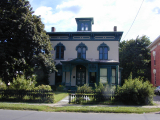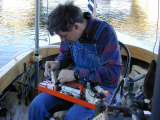 |
Fixing the steering mechanism. | | |
We got a very late start heading back south up the Oswego Canal.
We were waiting for Lock 2 at 11:45 a.m. In Locks 2 and 1, we were
now going up rather than descending. Lock 2, one again, proved to
be somewhat unpleasant. As it dumped, large quantities of milfoil emerged.
We had no option but to go through it. So much got tangled on the
propeller that we were unable to move until we had reversed the propeller
and gotten some of it off. While in the lock, Al poked with a fireplace
tool and removed some more.
Remnants of the old Oswego Canal and towpath were visible along the
east bank along parts of the river.
 |
Repair work. |
 |
The head (portapotty). | |
 |
Pump out. |
|
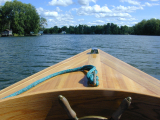 |
The Oswego Canal. |
We returned to Three Rivers and the Erie Canal, heading east again.
We headed up the canalized Oneida River whose source is Oneida Lake.
The terrain was mostly rural, with a few cottages and a few boats.
I had expected to see more. We went up through Lock 23 (lift 6.9
feet) near Brewerton, the busiest lock on the Erie Canal. We were
the only boat to lock through. That was the case on most locks, except
for our experiences on Sunday on the Oswego Canal. Normally, Lock
23 is used by pleasure boaters going to Oneida Lake, to the Oswego Canal
and Lake Ontario, and by those traversing the canal or using it instead
of a large lake during stormy weather.
 |
The gates of Lock 23 opening for us. A guard gate is visible. | |
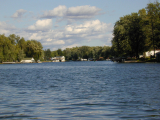 |
Brewerton. |
|
We arrived in Brewerton around 6:00 p.m. We had been listening to
the weather forecasts very carefully because we had to cross Oneida Lake.
This lake is twenty miles long, five miles across, and shallow. It
can be very treacherous when it is windy. According to the
forecast, the winds were to calm overnight. It was to cloud up after
midnight. There were showers forecast for the next day for the afternoon,
as well as for the subsequent day. The winds were at around 13 mph.
Because of the good short term forecast and worse longer term forecast,
it looked as if we had a choice of staying in Brewerton and getting up
very early to cross the lake the next morning or to cross it that night.
We decided to continue on that night, since otherwise we would have to
shut the fire down and get it started again. Also, we would have
clear skies during the early part of the night. We figured we would
get halfway across or so before we had no daylight left.
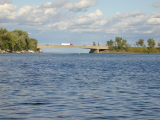 |
Brewerton. | |
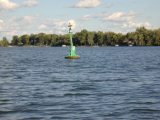 |
Buoy to starboard. |
|
Buoys mark the channel across the lake. As we set out from the western
end of the lake, we discovered that they were about two and a half miles
apart. With our short height, we couldn’t quite see from one to the
next. Fortunately, they were about a mile apart most of the way across,
except for the westernmost section. When it was dark, I could usually
see three as the boat rose up and down on the waves. The trick was
figuring out which was the closest one. The wind tended to blow the
steamboat off course and I had to correct for that.
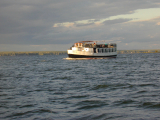 |
Tour boat Emita II on Oneida Lake. | |
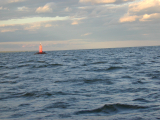 |
Buoy on rock to port. |
|
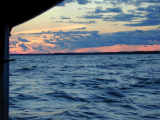 |
Waves due to thirteen mph winds at sunset. | |
 |
Green buoy 125 at night. Our halogen light shined on the reflective tape. |
|
The winds didn’t calm much. Over the course of more than four hours,
they decreased from 13 mph to 11 mph, then to 10 mph and 10 mph again.
There was heavy swell all the way across. The bow went up and down
two to three feet with the waves. I stood almost all the time the
entire way, navigating and steering.
Al made corn chowder and macaroni and cheese. (See food.)
He said he felt like a flight attendant on a rough flight.
Our main concern was that the steam engine would keep running all the
way across the lake (although neither of us dared mention it to the other).
The engine ran beautifully. Al kept the fire well stoked even at
the end, since we weren’t sure what we would encounter. He used much
more wood than usual.
The breakwater at the eastern end of Oneida Lake was very confusing
in the dark. It has a bend in it. Water washes over part of
the end of the breakwater. The brightest light is at the bend, not
the end of the breakwater. There is also a flashing white light on
shore that turned out to be a lighthouse. We could have made better
use of it. Further to the right was another flashing red light that
confused us.
It was a harrowing ride. The best part about it was that it was
done and we wouldn’t have to do it again.
When landing, I got out of the boat and hit my head on the canopy, acquiring
a large goose egg.
We arrived at 10:40 p.m., roughly four and a half hours after we started
across the lake.
We docked at the Sylvan Beach Terminal Wall, adjacent to the amusement
park. Some boys there had caught an eel about three feet long.
It was windy during the night, but it finally calmed down.
Number of locks: 3
Approximate distance for day: 38 miles
Next day Previous
day Steamboat trip index
